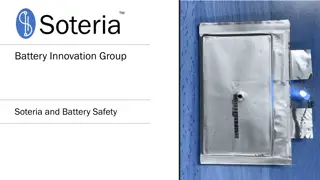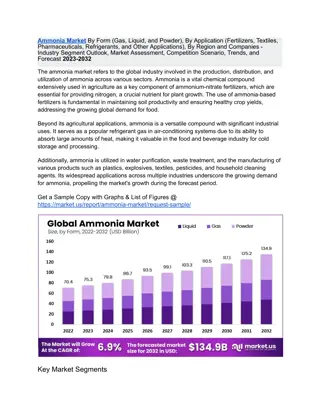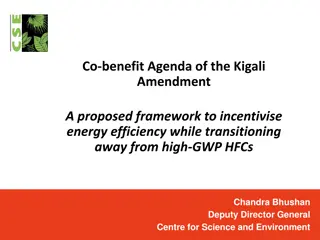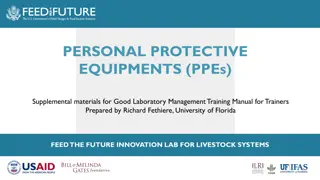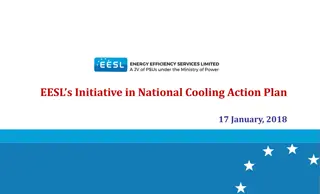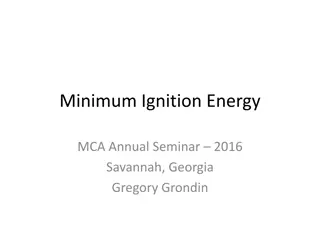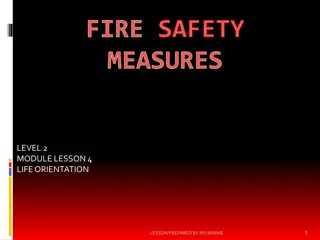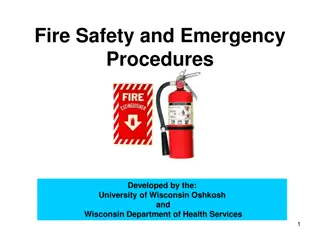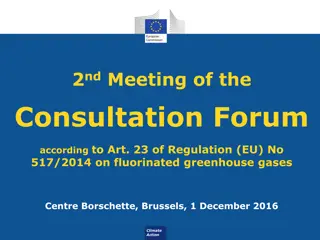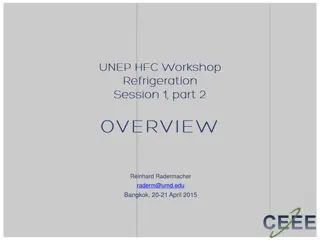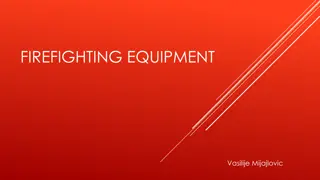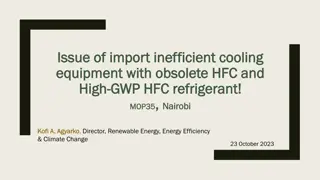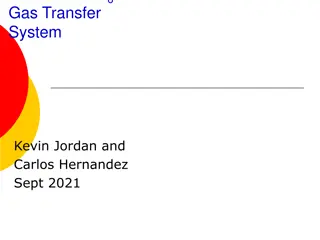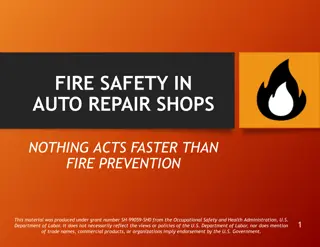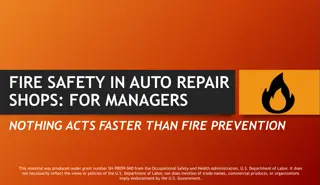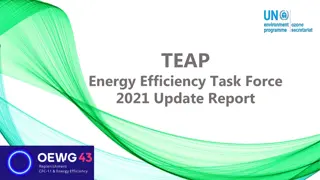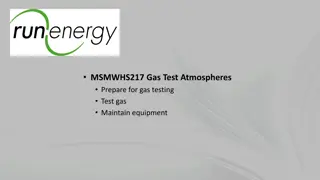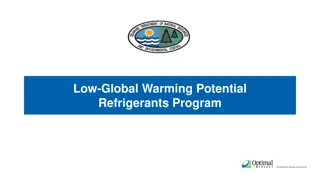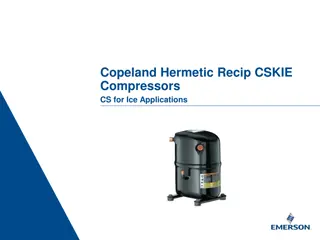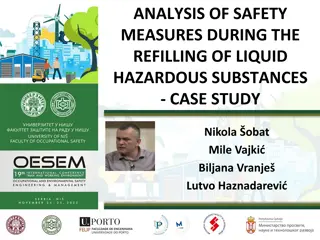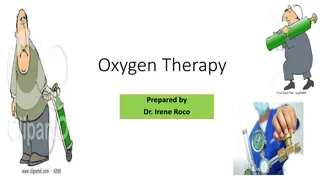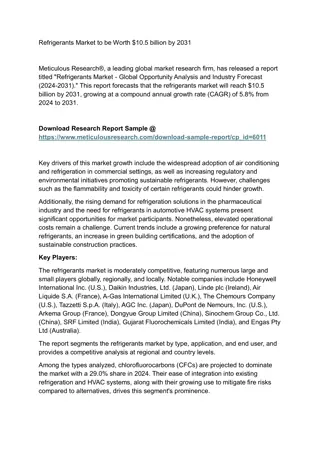Lithium-ion Battery Fire Risks and Safety Measures
Lithium-ion batteries pose significant fire hazards due to factors like flammable materials, manufacturing defects, and charging accidents. The frequent incidents of battery fires in various industries highlight the pressing need for improved safety measures. Current solutions, though existing, are
1 views • 12 slides
Investments in Ammonia Infrastructure Set to Boost Market Growth
Ammonia Market By Form (Gas, Liquid, and Powder), By Application (Fertilizers, Textiles, Pharmaceuticals, Refrigerants, and Other Applications), By Region and Companies - Industry Segment Outlook, Market Assessment, Competition Scenario, Trends, and
1 views • 3 slides
Transitioning Towards Energy Efficiency: Co-Benefit Agenda of the Kigali Amendment
The Kigali Amendment proposes a framework to incentivize energy efficiency while phasing out high-GWP HFCs. Reports highlight the urgency to limit global warming to 1.5°C, emphasizing the need for deep emission reductions across all sectors. Investments in low-carbon technologies and energy efficie
0 views • 17 slides
Best Practices for Laboratory Safety and Management
Promoting a safe laboratory environment involves following safety codes and assigning responsibilities for practices like hazard awareness, equipment use, and PPE. Good laboratory practices include proper storage and handling of hazardous chemicals, with a focus on flammable, corrosive, reactive, an
3 views • 17 slides
Energy Efficiency Services Limited (EESL) Cooling Initiative in India
EESL's initiative in the National Cooling Action Plan aims to address the escalating demand for air conditioning in India while promoting energy efficiency and sustainability. Through programs like the Bulk Procurement Mechanism and the EESL Super Efficient Air Conditioning Programme (ESEAP), EESL i
0 views • 9 slides
Understanding Minimum Ignition Energy (MIE) in Industrial Safety
Delve into the fascinating history and definition of Minimum Ignition Energy (MIE), exploring its origins, research milestones, and the critical role of the ignition kernel. Learn how MIE is used to assess the minimum energy required to ignite flammable materials, ensuring safety in industrial setti
4 views • 24 slides
Fire Safety Measures - Level 2 Module Lesson 4
Learn essential fire safety measures to prevent fires and protect yourself during emergencies. Understand fire risks, prevention techniques, and safe practices in the kitchen, with electrical cords, candles, smoking, and storage of flammable materials. Stay informed and prepared for potential fire h
0 views • 15 slides
Comprehensive Fire Safety and Emergency Procedures Training
This comprehensive training program, developed by the University of Wisconsin Oshkosh and Wisconsin Department of Health Services, covers essential fire safety and emergency procedures. Learn about identifying flammable materials, addressing special needs during emergencies, using fire extinguishers
0 views • 8 slides
Alternative Options for Small Commercial Cabinets in High Ambient Areas
Explore alternative options for plug-in small commercial cabinets in high ambient areas in the Southern African region. Self-contained refrigerated cabinets with integral condensing units and environmentally friendly refrigerants are discussed, along with challenges faced by independent companies an
0 views • 5 slides
Meeting Recap of Consultation Forum on Fluorinated Greenhouse Gases
The 2nd meeting of the Consultation Forum focused on providing advice to the Commission on implementing the F-gas Regulation. Topics included standards related to flammable refrigerants and strategies for addressing barriers. The need for updating standards, risk minimization approaches, and promoti
2 views • 25 slides
Comparison of Refrigerant Properties and Emissions in Refrigeration Systems
This content covers information on refrigerant properties for refrigeration equipment, including displacement volume, flammability, and performance metrics like COP and GWP. It also discusses total emissions comparisons based on material manufacturing, energy consumption, and refrigerant loss. Addit
0 views • 4 slides
Smell Synthesis Lab: Creating Sweet-Smelling Esters
In this lab, students will use chemistry to synthesize esters with pleasant scents by combining different molecules. Safety precautions include wearing goggles, using a hot plate, and handling flammable and caustic chemicals carefully. The process involves controlled chemical reactions to create new
0 views • 9 slides
Essential Firefighting Equipment on Ships
Shipboard fires are a significant risk due to high temperatures and flammable materials. To prevent and combat fires effectively, ships are equipped with fire retardant bulkheads, fire doors, fire dampers, fire pumps, fire main piping and valves, as well as fire hose and nozzles. These essential fir
0 views • 18 slides
Environmental Impact of Inefficient Cooling Equipment and Obsolete Refrigerants in Africa
The issue of importing inefficient cooling equipment with obsolete, high-GWP HFC refrigerants poses a significant environmental threat in Africa. Dumping new appliances with outdated refrigerants leads to wasted resources, air pollution, and climate change. This practice hinders Africa's development
0 views • 19 slides
Gas Transfer System Requirements and Hazards Overview
Gas transfer system requirements for SF6 include safe transfer between storage bags and high voltage tanks, with precautions to prevent gas loss or contamination. Hazards of SF6 include asphyxiation risk, cold burns, and toxicity. Material Safety Data Sheets and emergency protocols are essential for
0 views • 16 slides
Importance of Fire Safety in Auto Repair Shops
Fire safety is crucial in auto repair shops due to the presence of flammable fluids and ignition sources. This presentation highlights the evaluation of fire hazards and strategies to mitigate risks. Damage caused by shop fires can be devastating, leading to injuries and equipment damage. Learn from
0 views • 49 slides
Fire Safety in Auto Repair Shops: Prevention and Preparedness
Auto repair shops face high fire risks due to the presence of flammable materials like volatile organic compounds. This material provides guidance on fire prevention plans, communication, training, fire suppression systems, emergency action plans, and identifying/mitigating fire hazards. Learn from
0 views • 32 slides
Complete Fuel Tank Lightning Protection for Oil Storage Safety
Construction of large oil depots emphasizes the need for complete lightning protection to prevent tank fires. Flammable liquids and gases pose explosion risks, especially in floating roof tanks. Lightning-induced fires in crude oil production are a significant threat, highlighting the importance of
0 views • 10 slides
Impact of EU F-Gas Rules on Refrigerant Management
The new EU F-Gas rules aim to phase down high global warming potential refrigerants in Europe, promoting the use of lower GWP alternatives. Industry welcomes the regulations but calls for a focus on energy efficiency and overcoming barriers to adopting new refrigerants. Assessments highlight the eco
0 views • 9 slides
Asbjørn Vonsild Consulting: Expert in Refrigeration Standards and Flammable Refrigerants
Asbjørn Vonsild Consulting, led by Asbjørn Vonsild, specializes in standards and legislation within refrigeration, A/C, and heat pumps, particularly focusing on flammable refrigerants. As a key figure in various committees and working groups related to refrigeration safety standards, Asbjørn Vons
0 views • 20 slides
Understanding Refrigeration Cycles and Equipment
Explore the fundamentals of mechanical and absorption refrigeration, refrigerant heat absorption and rejection, compressor types, condensers, expansion devices, evaporators, and the operation of absorption refrigeration cycles. Learn about refrigeration capacity, refrigerants, halogen refrigerants,
0 views • 43 slides
Importance of NIK Alternatives in Phase Down of HFCs
NIK alternatives play a crucial role in phasing down high GWP HFCs, with a focus on next-generation solutions like HFOs and HFO/HFC blends. These alternatives have zero ODP and low GWP, making them effective replacements for various sectors. Regulations in the EU, US, Japan, and Canada are driving t
0 views • 15 slides
Addressing Energy Efficiency in Cooling Sector: 2021 Report Highlights
The 2021 update report from the TEAP Energy Efficiency Task Force emphasizes the critical nature of the climate emergency and the need to transition to lower GWP refrigerants and higher efficiency cooling systems. The report focuses on initiatives to enhance the efficiency of room ACs and refrigerat
0 views • 44 slides
Gas Testing and Hazardous Atmospheres: Preparation and Safety Guidelines
In environments with potential hazards, it is crucial to prepare for gas testing to ensure safety. This involves identifying the type of gas or atmosphere to be tested, understanding common gases, asphyxiants, irritants, and corrosives, and maintaining equipment for accurate testing. Hazardous atmos
0 views • 40 slides
Advancing Low-Global Warming Potential Refrigerants Program
Refrigerants play a vital role in heating and cooling systems, but some chemicals contribute to global warming. The Low-Global Warming Potential Refrigerants Program aims to promote the use of environmentally friendly refrigerants with a lower global warming impact. Delaware has an opportunity to le
0 views • 15 slides
Advancing Indian Leadership in Low-GWP Room Air Conditioning
This presentation highlights the rising demand for super-efficient room air conditioning in India driven by economic growth and increasing disposable income. With a significant portion of buildings yet to be constructed by 2030, the room AC market is poised for substantial growth. The imperative of
0 views • 12 slides
Enhancing Ice Applications with CSKIE Compressors
This presentation focuses on the innovative CSKIE compressors for ice applications, discussing their advantages over existing models in terms of efficiency, operating envelope, reliability, and refrigerants. The mechanical changes in CSKIE aim to improve efficiency and increase harvest capability, s
0 views • 15 slides
Enhancing Safety Measures for Refilling Hazardous Substances
Modern technical systems pose risks of accidents and injuries during the transport and refilling of hazardous substances. Preventive measures through engineering studies and adherence to international regulations like ADR are key to avoiding accidents. Special refilling stations equipped for safe tr
0 views • 10 slides
Comprehensive Guide to Oxygen Therapy and Safety Precautions
Oxygen therapy is a crucial medical intervention for various conditions, such as hypoxia, impaired gas exchange, and heart failure. This guide covers the administration of oxygen, types of oxygen supply, safety precautions, and devices used for oxygen delivery. Safety measures include avoiding smoki
0 views • 16 slides
Insights from HFC Stakeholder Survey December 2022
Causeway Solutions conducted an online survey of HFC stakeholders impacted by U.S. EPA decisions on HFC allocations. Key takeaways show stakeholders' views on HFC prices, inclusion of historical data in allocation methodologies, preference for suppliers, and stockpiling of HFCs for a smooth transiti
0 views • 15 slides
Refrigerants Market
Meticulous Research\u00ae, a leading global market research firm, has released a report titled \"Refrigerants Market - Global Opportunity Analysis and Industry Forecast (2024-2031).\" This report forecasts that the refrigerants market will reach $10.
1 views • 2 slides
